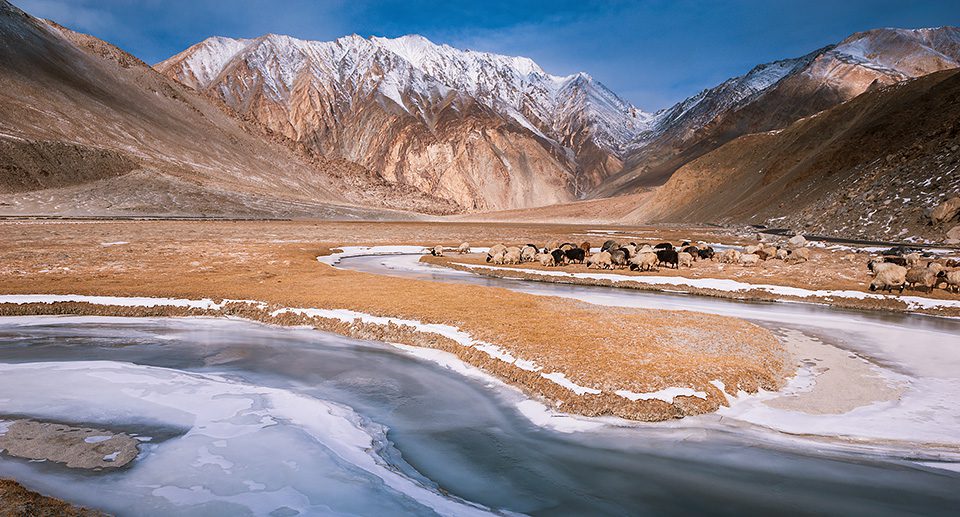Ladakh in winter transforms into a snow-clad paradise, offering visitors a magical experience unlike any other season. Known for its breathtaking frozen lakes, serene monasteries, and vibrant cultural festivals, Ladakh’s winter charm is a must-see for anyone seeking an extraordinary adventure in the cold desert. From the thrill of trekking on the frozen Zanskar River to participating in traditional Ladakhi celebrations, winter in Ladakh has something special for every traveler. This guide will walk you through everything you need to know to experience the best of Ladakh’s winter wonders.
Why Visit Ladakh in Winter?
Winter in Ladakh reveals a different side of this already unique landscape, providing an opportunity to experience solitude, adventure, and rich cultural traditions.
Experience the Serenity of Snow-Covered Ladakh
Ladakh in winter offers a peaceful escape, with fewer tourists and quiet, snow-laden streets and mountains. Places like Leh are transformed into winter wonderlands, allowing visitors to take in the vast, pristine landscapes without the crowds.
“The winter peace in Ladakh is surreal. Seeing the snowy Himalayas with almost no one around felt like being in another world.”
— Emma Stone, Travel Photographer, USA
Ladakh’s Unique Winter Culture and Traditions
Winter is when Ladakh’s vibrant traditions come to life, with local festivals such as Losar and Spituk Gustor attracting both locals and visitors alike. During these festivals, you’ll witness traditional Ladakhi dances, sacred rituals, and monks in colorful attire. These experiences provide a glimpse into Ladakh’s deep-rooted spirituality and cultural heritage.
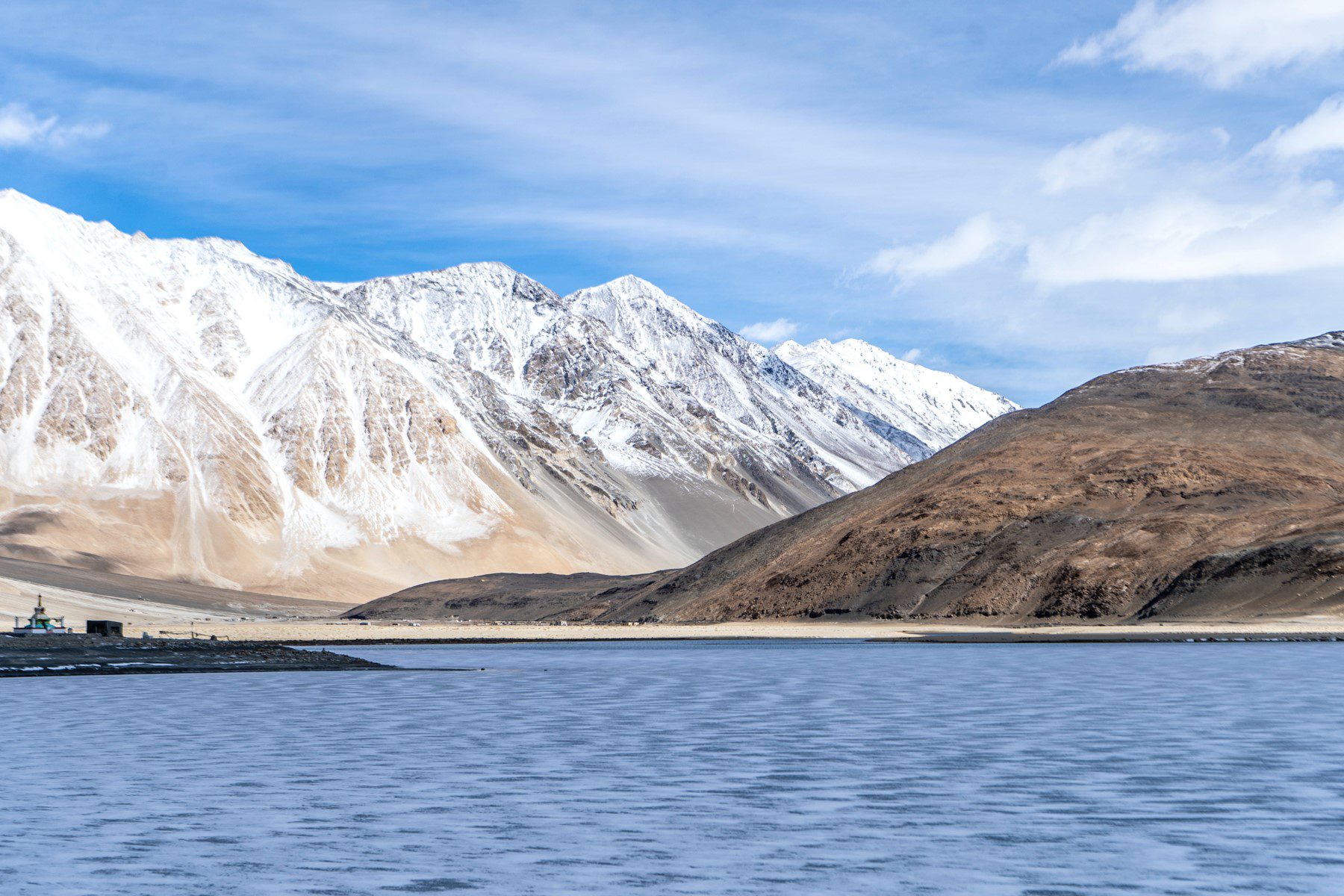
“Attending the Losar festival was unforgettable. It felt like stepping into a centuries-old tradition that celebrates everything Ladakh stands for.”
— Daniel Romero, Cultural Historian, Spain
Adventure Awaits: Winter Sports and Treks in Ladakh
For adventure seekers, Ladakh in winter offers adrenaline-pumping activities like the Chadar Trek across the frozen Zanskar River, snow leopard spotting, and even ice hockey on natural rinks. This combination of cultural richness and thrilling adventures makes winter the perfect season for a visit.
Weather in Ladakh During Winter: What to Expect
Winter in Ladakh is intense and requires travelers to be well-prepared. Understanding the climate helps you better enjoy the experience.
How Cold Does Ladakh Get in Winter?
Ladakh experiences extreme temperatures in winter, with daytime temperatures hovering around -5°C to -10°C (23°F to 14°F) and nighttime temperatures dropping as low as -20°C (-4°F). Expect sub-zero temperatures, so packing proper winter clothing is essential.
| Month | Average Day Temperature | Average Night Temperature |
|---|---|---|
| December | -5°C to -10°C | -15°C to -20°C |
| January | -10°C to -15°C | -20°C to -25°C |
| February | -8°C to -12°C | -18°C to -22°C |
Snowfall and Frozen Lakes in Ladakh
During winter, snowfall blankets Ladakh, transforming lakes like Pangong Tso and Tso Moriri into icy expanses perfect for photography and exploration.
“Seeing Pangong Lake frozen over was beyond words. It’s one of those sights that takes your breath away.”
— Lucas DeLuca, Landscape Photographer, Italy
Best Time to Visit Ladakh in Winter for Specific Experiences
For those interested in winter festivals, December and January are ideal months, while adventure seekers aiming for activities like the Chadar Trek should visit in January or February. Each month offers unique experiences, making winter an exciting season for Ladakh tourism.

Essential Winter Destinations in Ladakh
Leh: The Heart of Winter Tourism in Ladakh
Leh, the capital of Ladakh, offers numerous attractions such as Leh Palace, Shanti Stupa, and bustling winter markets where visitors can buy traditional handicrafts. The town remains accessible and retains its charm even in harsh winter conditions.
Frozen Beauty of Pangong Tso and Tso Moriri Lakes
These iconic lakes become dreamlike in winter, with ice crystals and stillness creating an otherworldly feel. Whether it’s for a photo opportunity or just to take in the beauty, visiting Pangong Tso and Tso Moriri in winter is a must.
“Standing on the edge of the frozen Pangong Tso, I felt a deep sense of peace. It’s something you don’t experience anywhere else.”
— Priya Singh, Travel Blogger, India
Nubra Valley: A Snowy Paradise
Known for the scenic Khardung La Pass, Nubra Valley offers sweeping views of snow-covered mountains. Although access is limited in winter, those who reach this remote area are rewarded with breathtaking vistas and a memorable adventure.
Top Cultural Wonders to Explore in Winter Ladakh
Monasteries to Visit During Winter in Ladakh
Ladakh is dotted with monasteries, and winter adds a special aura to them. Must-visit sites include Hemis Monastery, Thiksey Monastery, and Diskit Monastery. Visiting these sacred places in winter allows travelers to see monks chanting, conducting rituals, and keeping Ladakh’s ancient traditions alive.
“The monasteries in Ladakh have a magical quality in winter. The quiet, the prayers, and the snow all combine for a deeply spiritual experience.”
— Sven Johansson, Spiritual Seeker, Sweden
Ladakh’s Famous Winter Festivals
Festivals like Losar (Ladakhi New Year) and Spituk Gustor are highlights of Ladakh’s winter. During these festivals, you’ll see traditional performances and ceremonial events that offer a deeper understanding of Ladakhi culture and beliefs.
Traditional Ladakhi Cuisine and Winter Warmth
To combat the cold, Ladakhis enjoy hearty dishes like thukpa (noodle soup), momos (dumplings), and butter tea. Many restaurants and local homes open to tourists in winter offer these specialties, providing a taste of the region’s culinary heritage.
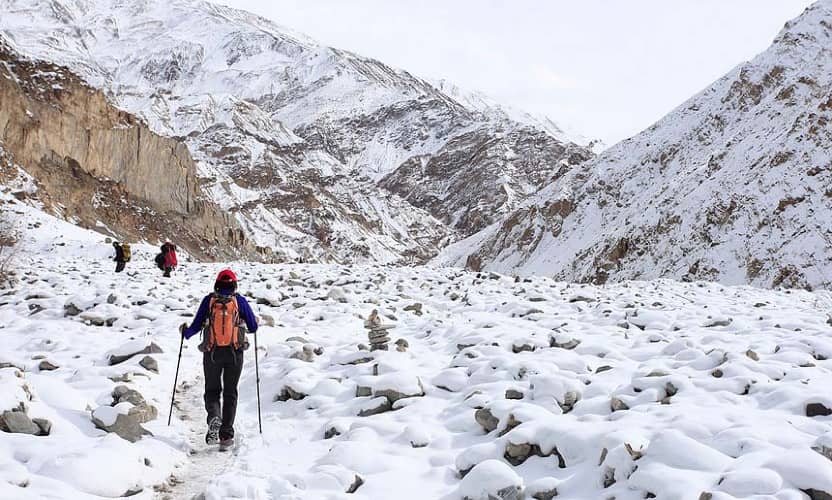
Adventure Activities in Winter Ladakh
The Famous Chadar Trek on the Frozen Zanskar River
The Chadar Trek is one of the most popular winter treks in Ladakh, taking adventurers on a journey over the frozen Zanskar River. It’s an experience that combines physical endurance with breathtaking scenery, ideal for seasoned trekkers looking for a challenge.
“The Chadar Trek was the most intense trek I’ve ever done. Walking on ice, through frozen valleys, is unforgettable.”
— Gabriel Martinez, Adventure Enthusiast, Argentina
Snow Leopard Spotting and Wildlife Adventures
Winter is the prime season for snow leopard spotting in Ladakh, particularly in Hemis National Park. Spotting this elusive creature in its natural habitat is a rare opportunity and a top highlight for wildlife enthusiasts.
Winter Sports and Ice Hockey in Ladakh
Ice hockey is a beloved winter sport in Ladakh, with local and international teams playing on natural ice rinks. Visitors are welcome to watch and even participate in games, making it a unique activity to experience in the cold desert.
Preparing for Your Winter Trip to Ladakh
What to Pack for a Winter Trip to Ladakh
Packing correctly for Ladakh’s extreme winter is crucial. Essential items include layered clothing, a heavy down jacket, gloves, thermal socks, and a sturdy pair of boots. Below is a recommended packing list:
| Essentials | Purpose |
|---|---|
| Down Jacket | For insulation against extreme cold |
| Thermals | Base layers for warmth |
| Insulated Boots | Protects against snow and ice |
| High-Altitude Sunglasses | UV protection in snowy landscapes |
| Lip Balm & Moisturizer | Prevents dryness in cold weather |
Safety Tips for Traveling in Ladakh’s Winter
When traveling in winter, it’s essential to take precautions for high-altitude acclimatization, frostbite prevention, and maintaining hydration. Additionally, carrying a basic first-aid kit is recommended.
“Safety is key in Ladakh’s winter. My first aid kit and extra layers really helped when temperatures dropped unexpectedly.”
— Laura K., Mountaineering Guide, Canada
Accommodation Options in Winter Ladakh
While many places may be closed, there are several warm, cozy options in Leh and nearby villages. Local homestays are a great way to experience Ladakhi hospitality and stay warm in winter conditions.
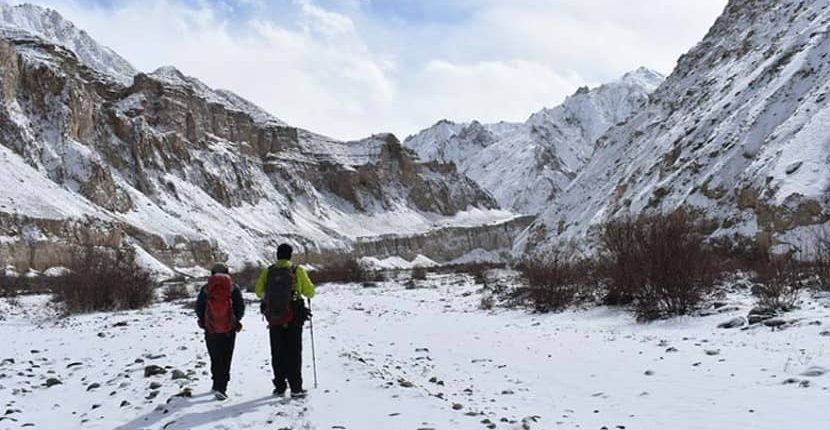
Traveling to Ladakh in Winter: Accessibility and Road Conditions
Reaching Ladakh by Air in Winter
Flying to Leh’s Kushok Bakula Rimpochee Airport is the most reliable way to reach Ladakh in winter. Although weather conditions may cause delays, the flights offer stunning views of the snow-capped mountains.
Winter Road Conditions: Leh-Manali and Leh-Srinagar Highways
Due to heavy snow, the Leh-Manali and Leh-Srinagar highways are closed in winter. Local travel within Leh can be done using cabs, but expect some icy road conditions. Plan to explore nearby attractions within a reasonable distance.
Local Transportation and Getting Around Leh in Winter
Traveling within Leh during winter is possible through local taxis and rental vehicles. Always check weather forecasts and road conditions before setting out, as icy roads can create unexpected challenges.
Photography Tips for Capturing Ladakh’s Winter Landscapes
Best Spots for Winter Photography in Ladakh
For photographers, Pangong Tso, Nubra Valley, and Hemis National Park offer fantastic winter shots. The frozen lakes, snow-clad peaks, and serene valleys make for perfect photo opportunities.
Preparing Camera Gear for the Cold
Cold temperatures can drain camera batteries quickly, so carrying extra batteries and keeping your camera insulated is essential. Additionally, a waterproof cover will help protect against sudden snow flurries.
Tips for Photographing Ladakh’s Wildlife in Winter
For snow leopard spotting, use zoom lenses and exercise patience. Morning and late afternoon provide the best light for capturing Ladakh’s elusive wildlife in action.
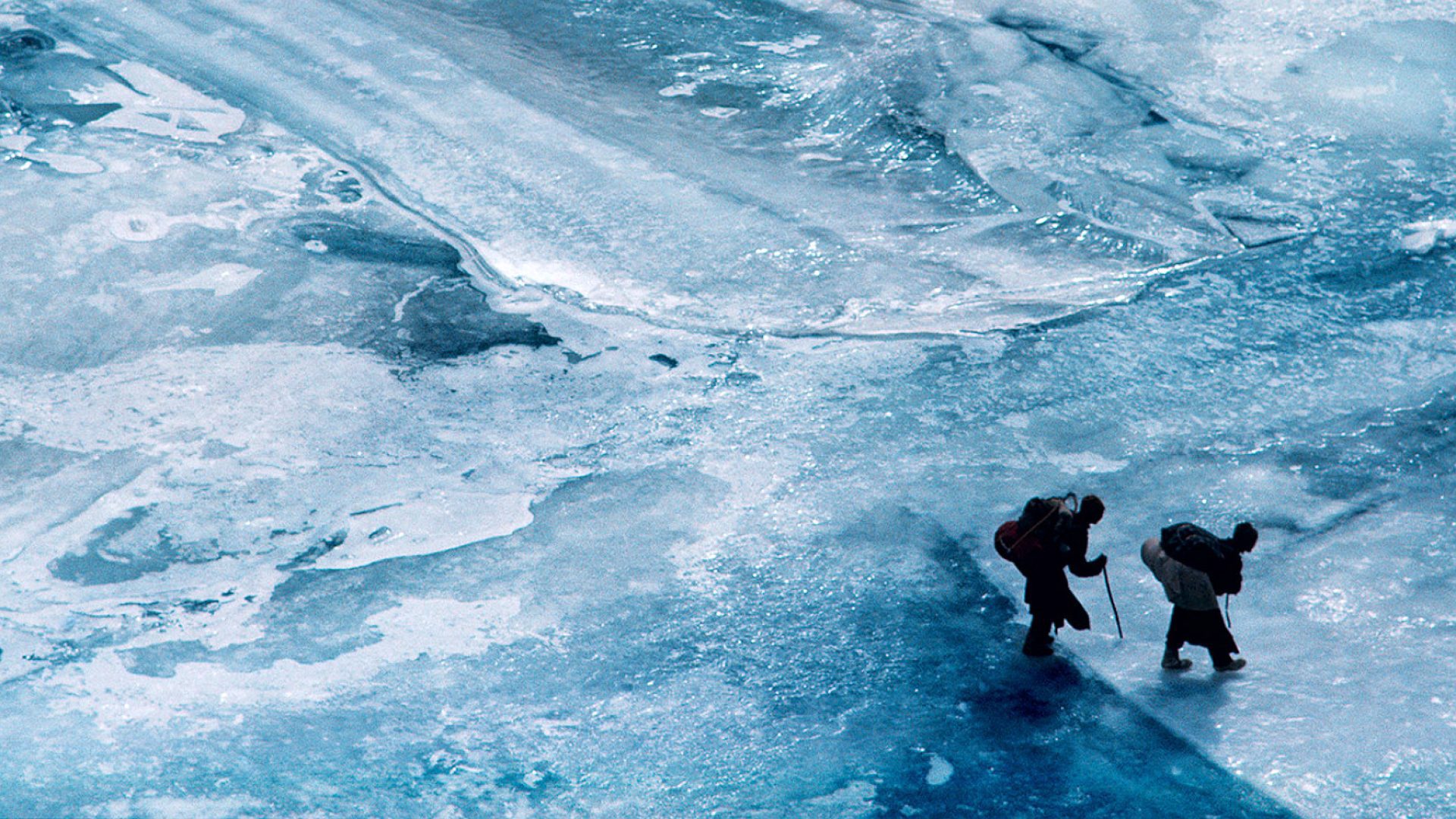
Frequently Asked Questions about Ladakh in Winter
Q: Is Ladakh Safe to Visit During Winter?
A: Yes, but it requires careful planning. Prepare for cold temperatures and ensure you’re equipped for high-altitude conditions.
Q: Can Tourists Access Pangong Lake and Tso Moriri in Winter?
A: Yes, although icy roads may make access more challenging, these lakes are accessible and provide stunning views when frozen.
Q: Do Winter Festivals in Ladakh Welcome Tourists?
A: Absolutely! Festivals like Losar are welcoming to tourists, offering unique insights into Ladakhi traditions.

